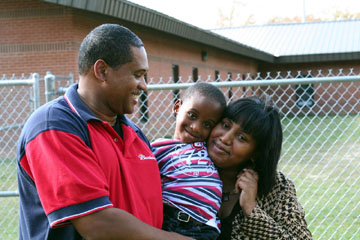MONROE, La.—Its official name is the Otto Bock Reciprocating Gait Orthosis, which is too much of a mouthful for 5-year-old Michael Johnson Jr. of Monroe.
So he calls his new trunk-to-heel brace system his “Batman suit.” The name reflects Michael’s fascination with super heroes, but this suit’s “powers” aren’t just make-believe. When the partially paralyzed youngster wears the braces, he can walk.
“I think that it’s the best thing that we live in an age now where we have the technology to do that,” said his dad Michael Johnson Sr. “I can’t wait to see the next generation.”
Chris Wallace, director of Methodist Orthotics & Prosthetics in Monroe, said Michael became the second person in the United States to be fitted with Otto Bock’s innovative system, due in part to Methodist’s collaborative relationship with the international company.
“We’ve had the opportunity to do early product testing and sampling for them because our size gives us access to a large variety of patient types,” Wallace said. “The payoff for our patients is we have the opportunity to disseminate new technology to appropriate clients.”
Born with spina bifida, Michael had tried braces before without much success. But Wallace believed the advances in Otto Bock’s design would make a difference for the active youngster.
The system weighs less than traditional braces, and its anatomical design fosters easier movement. “It’s less cumbersome to operate, so patients expend less energy to walk and their step cycle is more effective,” Wallace said. “It’s also much easier to put on and take off.”
Wallace said the system’s adjustability is another advantage, particularly for pediatric patients like Michael. “It has exchangeable elements, which make it a snap to adjust to a child’s growth,” he said.
There’s no doubt Michael finds his “Batman suit” empowering, said his mom Juan Burns.
“Before, he mostly got around on his knees. Now he likes to see us see him standing. If it makes us proud, he loves to do it.”
Michael also likes showing off his new equipment at Swartz Lower Elementary, where “the kids are all excited for him,” said his dad. “Michael has always had to look up to them and now he can get up on his braces and look at them eye-to-eye.”
On a recent weekday, Michael demonstrated his new abilities on the school playground, while two of his teachers proudly watched. “He has got an outstanding personality that is going to take him a long way,” said his preschool teacher Susan Jones. “Everyone loves him.”
“He doesn’t meet a stranger and he’s willing to try new things,” added adaptive physical education teacher Sharon Ratcliff. “It’s going to get him where he needs to be.”
That trademark enthusiasm has already helped Michael make great strides in therapy. Mandy Walker, a physical therapist at St. Francis Community Health Center in Monroe, said Michael has come a long way from the days when he could only walk about 20 feet with assistance. “At about six to eight weeks, he started walking by himself,” Walker said. “Now he’s walking about 300 feet in 20 minutes and I believe he’ll get faster and faster.”
While it may be impractical for Michael to use his braces all the time, Walker said he reaps definite benefits by being upright. The exercise is good for his cardiovascular system and the weight-bearing activities stimulate bone growth and help decrease spasticity.
Standing and walking also put Michael in the position for his favorite activity – socializing. “My incentive to get him to walk is to go visit people,” Walker said.
Walker said Michael also likes to pretend he’s “saving the world.” So she incorporates his hero fantasies into their therapy sessions. “I’ll say: Where’s Joker? Or let’s save the speech therapist from Penguin.”
Michael thinks the best thing about his braces is the emblem that Wallace incorporated into the design. “They’re cool because they’ve got Superman on them,” he said.
Considering all Michael has overcome, the emblem is symbolic of one little boy’s power to persevere. “The doctors said he might not be able to walk, or even crawl,” said his dad. “They also said he would have problems speaking and would probably be a short, round child and he would be slow in everything. So far, everything has been almost totally opposite.
“I think Michael will make a mark on this world intellectually that we won’t soon forget. He’ll be one of those kids who says: Don’t let my disability fool you.”



